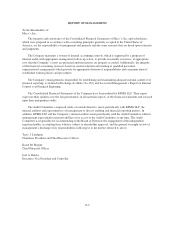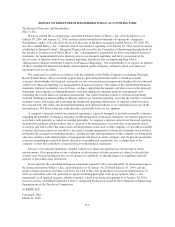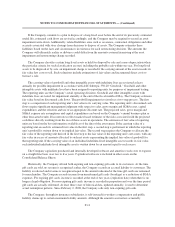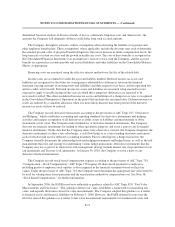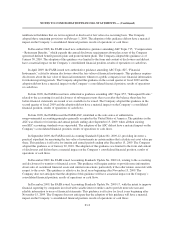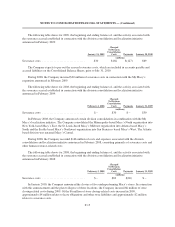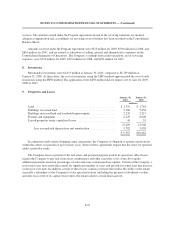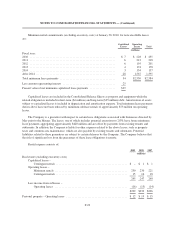Macy's 2009 Annual Report Download - page 60
Download and view the complete annual report
Please find page 60 of the 2009 Macy's annual report below. You can navigate through the pages in the report by either clicking on the pages listed below, or by using the keyword search tool below to find specific information within the annual report.
NOTES TO CONSOLIDATED FINANCIAL STATEMENTS — (Continued)
determined based on analysis of historical trends of losses, settlements, litigation costs and other factors, the
amounts the Company will ultimately disburse could differ from such accrued amounts.
The Company, through its actuaries, utilizes assumptions when estimating the liabilities for pension and
other employee benefit plans. These assumptions, where applicable, include the discount rates used to determine
the actuarial present value of projected benefit obligations, the rate of increase in future compensation levels, the
long-term rate of return on assets and the growth in health care costs. The cost of these benefits is recognized in
the Consolidated Financial Statements over an employee’s term of service with the Company, and the accrued
benefits are reported in accounts payable and accrued liabilities and other liabilities on the Consolidated Balance
Sheets, as appropriate.
Financing costs are amortized using the effective interest method over the life of the related debt.
Income taxes are accounted for under the asset and liability method. Deferred income tax assets and
liabilities are recognized for the future tax consequences attributable to differences between the financial
statement carrying amounts of existing assets and liabilities and their respective tax bases, and net operating loss
and tax credit carryforwards. Deferred income tax assets and liabilities are measured using enacted tax rates
expected to apply to taxable income in the years in which those temporary differences are expected to be
recovered or settled. The effect on deferred income tax assets and liabilities of a change in tax rates is recognized
in the Consolidated Statements of Operations in the period that includes the enactment date. Deferred income tax
assets are reduced by a valuation allowance when it is more likely than not that some portion of the deferred
income tax assets will not be realized.
The Company records derivative transactions according to the provisions of ASC Topic 815 “Derivatives
and Hedging,” which establishes accounting and reporting standards for derivative instruments and hedging
activities and requires recognition of all derivatives as either assets or liabilities and measurement of those
instruments at fair value. The Company makes limited use of derivative financial instruments. The Company
does not use financial instruments for trading or other speculative purposes and is not a party to any leveraged
financial instruments. On the date that the Company enters into a derivative contract, the Company designates the
derivative instrument as either a fair value hedge, a cash flow hedge or as a free-standing derivative instrument,
each of which would receive different accounting treatment. Prior to entering into a hedge transaction, the
Company formally documents the relationship between hedging instruments and hedged items, as well as the risk
management objective and strategy for undertaking various hedge transactions. Derivative instruments that the
Company may use as part of its interest rate risk management strategy include interest rate swap and interest rate
cap agreements and Treasury lock agreements. At January 30, 2010, the Company was not a party to any
derivative financial instruments.
The Company records stock-based compensation expense according to the provisions of ASC Topic 718,
“Compensation – Stock Compensation.” ASC Topic 718 requires all share-based payments to employees,
including grants of employee stock options, to be recognized in the financial statements based on their fair
values. Under the provisions of ASC Topic 718, the Company must determine the appropriate fair value model to
be used for valuing share-based payments and the amortization method for compensation cost. See Note 16,
“Stock Based Compensation,” for further information.
In September 2006, the FASB issued new authoritative guidance related to ASC Topic 820, “Fair Value
Measurements and Disclosures.” This guidance defines fair value, establishes a framework for measuring fair
value, and expands disclosures about fair value measurements. The Company adopted this guidance as it relates
to financial assets and financial liabilities on February 3, 2008. However, the FASB deferred for one year the
effective date of this guidance as it relates to fair value measurement requirements for nonfinancial assets and
F-12


